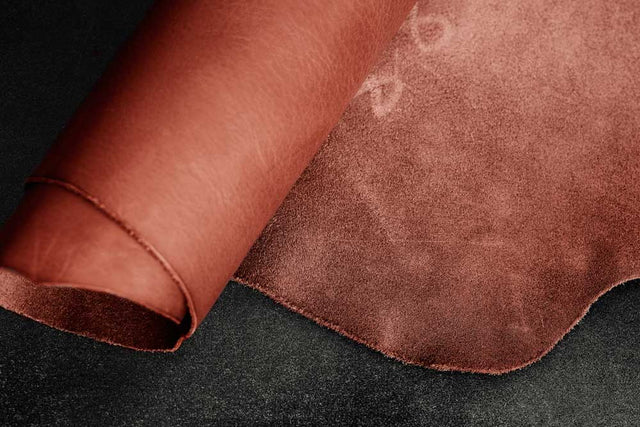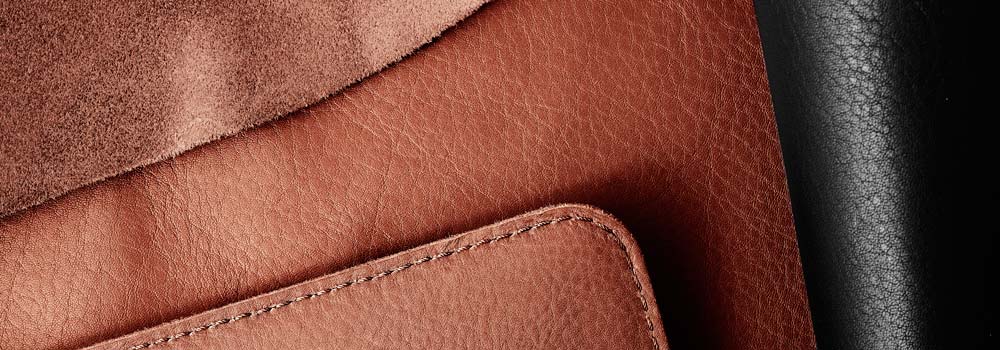
About Different Leathers
In this short article, we will give you a brief understanding of the basics of leather and why we use full-grain leather of Scandinavian origin for our WOOLNUT MacBook sleeves and other accessories. We will cover the following subjects:
- What is Leather?
- What is full-grain leather?
- What is tanning?
- About chrome tanned leather
- About vegetable tanned leather
- Full-grain leather from Scandinavia

What is leather?
Leather is a flexible and tactile material with a history spanning thousands of years back in time. It is made from the skin of a dead animal and most typically today; a cow hide. Instead of this skin becoming a waste product of the dead animal, it can be transformed into leathers with a multitude of uses. It is the layer of the skin called corium and its junction to the grains that leatherworkers find very valuable. This consists of protein collagen built as fibers and grouped into bundles. The interweaving of these fiber bundles gives leather its unique strength, structure, adaptability, flexibility, elasticity and the ability to breathe. The fibers are finer and more closely woven towards the surface of the grain.
Full-grain leather

This leads us to the different layers of leather, where full-grain leather is widely recognized as the best-quality leather on the market. The entire grain of the hide is used as well as the corium interface (often known as corium junction). This leaves the imperfections and inherent toughness on the surface. With time, this leather will soften and develop a rich patina, leaving it more and more beautiful as it is being used. Imperfections in the full-grain leather could be small marks or subtle blemishes. This makes each and every full-grain leather piece unique. This leather is also more durable and if you take care of your product made from full-grain leather, it could be your partner for the rest of your life. It will also grow more beautiful each day. Now that you know what full-grain leather is, let's look into the basics of tanning leathers.
What is tanning?
Tanning is a process which alters the highly complex nature of skins or hides into a sophisticated, durable and stable material that we know as leather. This process has been around in one form or another for thousands of years. Before the tanning process can begin, a series of pre-tanning operations such as soaking, liming and splitting is required in order to prepare the material. The tanning in itself takes place at the tannery where different liquids, agents and chemicals could be used to alter the leather together with processes such as stretching or tumbling. There are basically two tanning methods used in the world today; chrome tanning and vegetable tanning.

Chrome tanned leather
Chrome tanning was developed towards the end of the nineteenth century and facilitates for mass production of chrome tanned leathers. This is due to the speed and efficiency of this method. Today, chrome tanned leather is by far the most used throughout the world. The leather is widely used in for example clothes, shoes and upholstery. The chrome tanning uses chemicals such as chromium salts. The chemicals can make the leather water-resistant and it can easily be dyed in different colors. It gets a protective surface that many times does not change much over time. Chrome tanning is a much faster process of tanning compared to vegetable tanning. A batch of chrome tanned leather could be completed in a single day while the vegetable tanned leather could take up to 60 days to be fulfilled. This is the main reason why chrome tanned leathers are much cheaper than vegetable tanned. As an end-product, the chrome leather gets a more artificial feel to it than vegetable tanned leather would ever get.
However, there are also a lot of different variations of chrome tanned leathers and what makes them good or bad for various types of products. Chrome tanning can also make leather very soft and supple, and resistant - all features suitable for a lot of products. Since it is also a much more widely used tanning method, it often uses modern techniques that could also reduce environmental impact in different ways.
Vegetable tanned leather
Vegetable tanning is the most traditional and natural tanning method of them all. It has been around for centuries and has since then been perfected in every possible way. The leather can also be recycled and is biodegradable. For vegetable tanning, tannins are used (hence the word tanning). This is a substance that naturally occurs in for example bark. The bark of trees like oak, chestnut, mangrove and many more are used to extract tannins into which hides are immersed for several weeks. The leather gets a wonderful earthy, woody and natural smell - but the method is costly due to the traditional process, the need of highly skilled craftsmen and the long production time.
Full-grain leather from Scandinavia

The full-grain leather of Scandinavian origin that we use in our WOOLNUT products holds exceptional characteristics. It is one of the most exclusive leathers, much due to the mild northern climate of countries like Sweden, along with farmers complying with the highest standards of animal welfare in the world. The leather has durability and strength. It is irregular and unique in a natural way, with genuine aesthetics.
When we combine this leather with 100% natural wool felt lining, our MacBook leather sleeves and iPad leather sleeves truly come to life. These materials blend together perfectly, resulting in unmatched beauty. The soft, water-repellent and shock-absorbent wool does not only look stunning together with the leather but also helps protect the MacBook or iPad through everyday life. However, the backbone of our products has always been our premium full-grain leather of Scandinavian origin. And after reading this short article, we hope that you will appreciate this part of our products just a little bit more.
